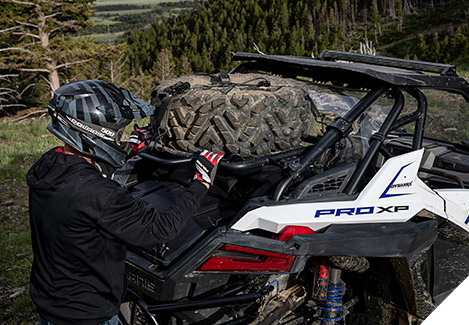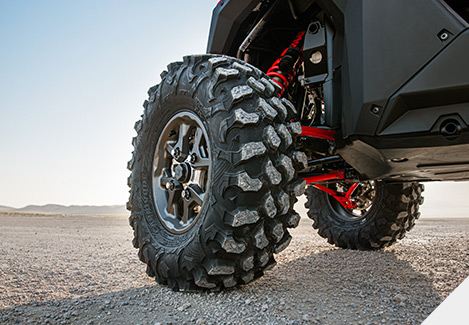
Picking the Right Tires For your Off-Road Vehicle (ORV)
The Ultimate Off-Road Tire Guide
Tire selection is important when setting up your off-road vehicle. In this guide, we’ll run through common types of ATV and side by side tires, their designs, and the criteria you should be looking at when selecting the best type for your vehicle. We’ll also touch on ORV tire maintenance and how to keep tabs on tire condition, both for your safety and the performance of your off-road vehicle.
Types of SxS UTV or ATV Tires
At first glance, there’s a wide variety of UTV and ATV tires that can seem intimidating. In this section, we’ll break down some of the main ways that ORV tires can be differentiated, and why you might opt for one style over another.


Flat, Round Top, Bias Ply, and Radial Tires
Among the most fundamental differentiations within UTV/ATV tires lies within their inner construction: namely, how the interior plies—the tire’s cords or belts—are oriented. Bias ply tires are made from cords overlain diagonally in a crisscross pattern between the beads. Radial tires are made with interior plies arranged perpendicular to the tire centerline and capped under the tread with a steel belt.
With their tight grip and stiff sidewalls, bias ply tires are often favored by off-roaders for particularly rough terrain. More flexible radial tires, typically have broader contact with the ground, tend to provide better handling at higher speeds, better fuel economy, and lesser rates of tread wear.
Years ago, ply rating referred to the number of plies within a tire; a 4-ply tire encompassed four plies. Today, this isn’t the case. The ply rating reflects the tire’s overall strength and load capacity. An 8-ply tire is stronger and heavier than a 4-ply tire, which is stronger and heavier than a 2-ply tire. We’ll touch again on ply rating and how it applies to different styles of ATV/UTV tires; it’s an important number you’ll want to key into when choosing what tire’s best for your kind of riding.
Another basic difference comes in the shape of the top of the tire. ATV/UTV round top tires perform well on a variety of different surfaces and tend to deliver a fairly smooth ride. ATV/UTV flat top tires connect more of the tire tread to ground offering greater stability. A flat top is most commonly seen in racing/sport tires, while round-top tires are usually the go-to for recreation and utility ORVs.
Types of Material for UTV & ATV Tires
Within the rubber-polymer exterior of an ATV/UTV tire, the plies are typically constructed of nylon, polyester, Kevlar, or steel.
Types of Tread on Side by Side & ATV Tires


The tread of your ORV tire—where the tire meet the ground—is one of its most critical design components. Different UTV/ATV tread patterns divide off-road tires into different categories: sand tires, mud tires, racing tires, and all-terrain tires.
- Sand Tires: These unmistakable tires have the most specialized ATV/UTV tread patterns of all. The rear tires have paddle-like ridging to help dig into the sand, while the front tires may be completely smooth or have a few ridges for steering purposes. These sparsely treaded tires are designed specifically for use on soft sand, and typically have a lightweight 2-ply construction.
- Mud Tires: Mud tires are the gnarliest-looking ATV/UTV tires, boasting especially deep tread—better than an inch in some tires—and plenty of space between the lugs. This rugged lugging provides aggressive grip in slick and sloppy conditions, and the angled, flaring-out ridging makes mud tires “self-cleaning.” When spinning, the tread shoves mud outward from the centerline, helping keep the lugs clear. Mud tires tend to be on the order of 6-ply or more ,though lighter options are available. Some four wheeler and SxS owners opt for medium- or shallower-tread mud tires if they know they’ll also be doing some general off-roading.
- Racing Tires: These specialized tires have flat tops and knobby tread for performing well on packed trails at higher speeds. They typically come in 2-ply to 6-ply ratings.
- All-Terrain Tires: These ATV/UTV tires—also called all-purpose tires—represent a versatile middle ground, with a tread designed to tackle a wide range of different surfaces. Therefore, they're often the tires of choice for every day, general-purpose riders.
If you’re only looking to have one set of ATV or UTV tires, the all-terrain style, may be the way to go. If you occasionally hit the mud or dunes, a separate set of mud or sand specific tires is going to be well worth the investment.
UTV Tire Sizes & How to Read Them
Now, what do those numbers mean embossed on your UTV or ATV tire’s sidewall? Let’s take one of the mud tires we sell here at Polaris, the Pro Armor® Mud XC, as an example for how to read UTV tire size and ATV tire size.
Its sidewall displays: 27 x 11 R14. The first number, 27, refers to the tire’s diameter in inches. The second, 11, is the tire’s width. “R” means “radial,” identifying this as a radial-ply tire. The last number, 14, gives you the rim diameter of the wheels that’ll accept this tire.
Off-Road Tire Maintenance


Properly maintaining your ATV or UTV tires allows you to get the most life out of them and stay safe while you’re riding. It’s important to keep your tires at the proper air pressure, and to give them a once-over before and after each ride to make sure they’re still in adequate shape. Your tire manufacturer should also provide recommendations for safe tire depth, and when they believe you switch out your tires for a new pair.
What is the Best Tire Pressure?
Tire pressure is all too easily overlooked by off-road riders, but it’s hugely important. Improperly inflated tires can cause performance and handling issues, from leaning to one side or the other, to all-out loss of control and blowouts. They will also wear unevenly, necessitating premature replacement.
You’ll find the recommended tire pressures, including for different passenger and cargo loads, in your owner’s manual and printed on your ATV or UTV. Check your tire pressure using a low-pressure gauge before your ride, when you’ll get the most accurate reading, and otherwise wait several hours post-riding for the tires to cool.
When to Replace Your UTV Tires
Tire manufacturers provide recommended replacement intervals for a tire based on mileage and time. While this provides a benchmark, you still need to visually inspect your tires on a regular basis to look for signs of damage and wear. Things to watch out for include dry or cracked rubber, worn-down or uneven lugs, bulging sidewalls, embedded nails or other foreign objects, and punctures.
Replace all your tires if any show signs of age-related wear and tear. Failing tires put you at risk, and puts excess stress on your vehicle’s drivetrain and suspension.
Tire Truths
It’s easy to take ORV tires for granted, even though they’re as vital a component of your machine as the engine. Take the time to consider the styles of tires best suited to the kind of off-roading and work you hope to do with your UTV and ATV. In terms of maintenance, it is important to always stay on top of upkeep, and replacement so you’re getting the most out of your tires and keeping your vehicle as safe and high-performing as it can be.





